#but the idea of expressionism being subjective
Text
Unusual Character Associations
I was tagged by @houndsofcorduff to play a game created by @thenightmarewrites, where (as far as I understand it) I list what comes to mind when I associate specific words with my OCs. Thank you for the tag, and the chance to think more deeply about some of my OCs!
I’ll tag @aohendo, @calicojackofficial, @wildjuniperjones, @inkspellangel, @did-i-do-this-write, and as always anyone who wants to join in can say I tagged them!
For this list, I chose River Page from my novel WIP “To Be Honest” as my associative OC (the co-main character to and love interest of Micah Renner).
Seasoning: basil
Weather: a lightly chilly Spring breeze, the kind you get when Winter has just barely ended, on a sunny day just after it’s rained
Color: light orange
Sky: mostly clear, but with the kind of slow-moving, lazy clouds that make it look like it could rain but probably won’t
Magical Power: flight
House Plant: bonsai tree
Weapon: staff/cane
Subject: art
Social Media: nextdoor, if that even counts as social media
Makeup Product: mascara
Candy: m&ms
Fear: crowds
Ice Cube Shape: cyllindrical
Method of Long-Distance Travel: trains
Art Style: expressionism
Mythological Creature: phoenix
Three Emojis: 😇😅💜
Celestial Body: pluto
#writing#sonder lore#sonder oc#unusual character associations#bonus fact#I didn't plan the colors at all#but orange is complementary to blue#Micah's color is blue#I accidentally made the leads complementary#which is true of their personalities in canon#also their relationship#that's part of why they fall for each other#but doing it again#by accident#I can't believe it happened#also#I looked up art styles for this#I almost chose fauvinism#but the idea of expressionism being subjective#due to being centered in emotion more than concept#that resonates with changelings#especially River
1 note
·
View note
Text
Rise Characterizations Pt. 3!!!
Now that Leo and Raph are done, it's Donnie's turn for character analysis as a writing reference. So without further ado,
Donnie Character Notes
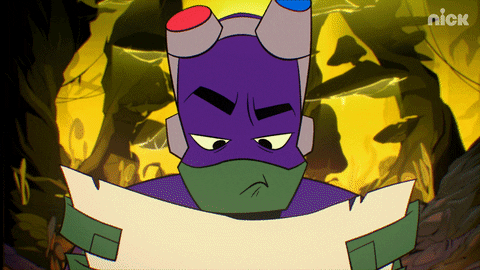
Language Habits:
Straight up talks like a redditor who hasn't touched enough grass (affectionate)
Oscillates between very scientific paper polished, sometimes adding a dazzle of shakespearean for dramatics, or abbreviations/a shorter version of a word with a more fun connotation (i.e. "brekkie" instead of breakfast)
Uses food as surprised exclamations or curses, "oh my peaches and cream", "banana pancakes!"
Emphasizes each syllable of a long word when he's excited or trying to make a point. Conquered becomes con-qu-ered
Either exaggerates his speech or speaks in deadpan
The science terms he uses as battle cries aren't chosen at random, but rather are related to the action/subject at hand, i.e. yelling "fibonacci" when throwing his spinning tech-bo
Will overly describe an item or a situation, and often gets caught up in these observations before processing what just happened
Will repeatedly yell "help!" when he's distressed and/or outnumbered
Refers to Mikey as "Michael"
Refers to his brothers as "brethren" or "gentlemen"
Refers to splinter as either "father", "papa", or "dad" depending on the weight of the situation
Refers to his tech as his "babies"
Answers the phone with, "You're conversing with Donatello"
Uses "gesundheit" instead of bless you
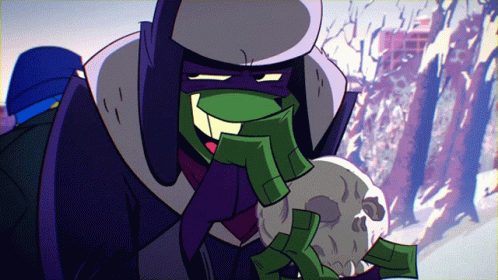
Personality:
The fixer, he supplies the family with tech and resources. He always has a trinket made for the situation at hand and/or offers his knowledge/data collected. He's always prepared to help. Even with outside resources, he likes to feel useful in solving their problems (i.e., building Todd that dog park)
The theater kid, in a similar vein to leo, Donnie has his own style of dramatics. He often uses shakespeare-like language, is mentioned to regularly recite the jupiter jim musical soundtrack, and has a music mode for his battle shell. He belongs on a stage, or at least thinks he does
Not good at lying, despite the glamour he can put on in the spotlight. This may be due to the side of himself that over explains his thoughts
An over-thinker, who really tends to over-complicate things. His first theory or idea will always be the most extreme buck-wild concept. After some filtering, he still word vomits
A dreamer/big idea guy. He does have big ideas and goals. A lot of these he's able to put into place, although some go a little haywire (see Albearto). He doesn't do things in halves, and puts everything into a project
Meticulous, someone who's very detail oriented. As mentioned before he tends to over-complicates things. This may be impacted by his love for data and collecting information (he does record Everything for a reason)
Always on the edge of violence, which is surprising. Donnie's not known as being the angry archetype of tmnt, but he can get a little violent in his fighting style and does often cite his desire to use lethal force
Low empathy, which is mainly due to his issues processing and recognizing emotions. He's been pegged as unemotional, but in canon he's rather emotional and expressionate, just lacking the skills to process such emotion (he's just like me fr)
Praise motivated, as seen with his interactions with Splinter. Also desires the praise of his brothers, who he doesn't feel understand him with all the teasing that's sent towards his direction. This also pushes him to seek validation and acceptance in other groups (i.e. the purple dragons), to feel a sense of security or belonging
Ignores his own mistakes, and will often pretend like they didn't exist or ever happen. This most likely has to do with his desire for praise, so he feels bad when he fails. If he never made a mistake, he never has to feel bad

Miscellaneous:
Fourth to unlock mystic powers
Uses "Bootyyyshaker9000" as most of his usernames and passwords, with his alt. username being "Alpha-Bootyyyshaker9000"
Has a fear of bees, spiders, and of course beach balls
Breaks the fourth wall the most
Loves the smell of pineapple, hates the texture
Has a hobby of rooting around in the junkyard and dumpster diving
Uses cheat codes in video games
Mikey's next of course :)
#rise of the teenage mutant ninja turtles#rise of the tmnt#rottmnt#tmnt#teenage mutant ninja turtles#rottmnt donnie#rottmnt donatello#character analysis#long post#fanfic#writing#critter talks
2K notes
·
View notes
Text
okay Riverdale post simulator go

🖋️ narratorconfessions follow
hey guys i've been feeling pretty bored with the way this narrative has been unfolding tbh... what situation should i put my friends into next? haha
15 notes

🪓 dancinginthedark-mp3 follow
Does anybody else feel the Darkness encroaching?
🪓 dancinginthedark-mp3 follow
You guys seem to think I am joking. This is not a joke. It is in the room with me.
🪓 dancinginthedark-mp3 follow
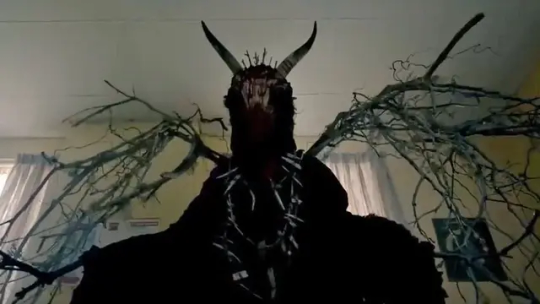
Honestly it is off-putting in a fashionable way. What do you guys think?
30k notes

💋 livinghauntedhouse follow
haters will say my delusions are negatively impacting my life but all this lesbian sex i'm having suggests otherwise. it's all about the Gothic Femme mindset, you lumpen ne'er-do-wells.
208 notes

🎵 notsoallamerican follow

I really admire their friendship! Wish my guy friends wanted this same type of bond
🎭 offbroadwaybound follow
they were both bisexual and without a doubt fucking
🎵 notsoallamerican follow
What's bisexual???
3 notes

💎 designerbeauty follow
I'm just a classy woman looking for the Eduardo to my Mark. Literally WHAT is so unreasonable about this...
80 notes

💻 jugheadofficial follow
It's really hard being a sensitive straight guy. I love my friends, but they just can't understand what my life is like. New novel idea maybe? :/
🎵 notsoallamerican follow
Jughead :(
💋 livinghauntedhouse follow
can you invent a real problem you ghoulish closet case? some of us were sent to conversion therapy
💻 jugheadofficial follow
How did you do this to my post?
-1k notes
#riverdale#jughead jones#betty cooper#cheryl blossom#archie andrews#kevin keller#veronica lodge#a day in the life
631 notes
·
View notes
Text
i think it's funny that the first thing people go to when trying to discuss the idea of reshaping work and capitalist society is that "you just want an excuse to sit around and contribute nothing" when in actuality, i would be contributing far more to society if i wasn't chained to a desk 40~ hours a week or beholden to company-sponsored health insurance in order to survive.
here's a list of things i'd rather be spending my time providing to society rather than working 40 hours a week doing something i could not possibly give a fuck less about:
teaching - adults, children, general education, coaching sports
writing - fiction, non-fiction, philosophy, essays, comedy
art - painting, abstract expressionism, contemporary pieces
music - lyrics, beats, melodies
helping others - friends, neighbors, strangers; with whatever they need, however they need it, volunteering my time
helping animals - rehabbing, care taking and husbandry
tending to the planet - gardening, planting trees, trash pickup, farming
archiving - safely storing everything we've created; physically & digitally
i could truly go on and on and on with more things that i would be spending my time doing if i wasn't constantly held underwater by the capitalist machine. and i don't want anything in return; the free time to do these things and share in the creations of others is reward enough.
does this sound like an unmotivated individual who wants to do nothing? quite to contrary, in my humble opinion. i simply would like the freedom to choose the things that fulfill me in my quest for meaningful time spent, rather than being subject to the wills of a conglomerate making an ungodly amount of money, of which i see .00002% of the revenue.
116 notes
·
View notes
Text
Unusual muse associations
Thank you @ladyshivs and @rab-bitly for the tag!✨ Sorry i took a while, this was so difficult hahahaha
Levi Turner || Sidestep || Reckoning

SEASONING: Cracked pepper
WEATHER: The warm dry wind preceding a drastic change in temperature.
COLOUR: Neutrals, browns, desaturated greens.
SKY: Completely overcast, bright white skies. Stuck between cloudy and sun.
MAGICAL POWER: Telepathy and empathy are such a part of his character, I’m sticking with that.
PLANT: Thistle. Striking, stubborn, hardy, and sharp.
WEAPON: Dented aluminum bat.
SUBJECT: sociology, applied mechanics
SOCIAL MEDIA: Lurking in conspiracy forums.
MAKEUP PRODUCT: i have literally no idea
CANDY: One of those awful cereal and milk bars.
FEAR: fear of being buried, or fear of pressure, of being crushed
ICE CUBE SHAPE: hahaha uhhh irregular and broken
METHOD OF LONG-DISTANCE TRAVEL: Road trip in a shitty old car with no air conditioning, or a tiny one-man fishing trawler, also old and beat up.
ART STYLE: Expressionism
MYTHOLOGICAL CREATURE: Werewolf
PIECE OF STATIONERY: Sharpie
THREE EMOJIS: 💢👊💥
CELESTIAL BODY: Jupiter
#levi#I don’t feel like tagging people but hey you#yes you#you know you wanna do this too#i wanna know about your ocs
29 notes
·
View notes
Text
Exhibition Catalogue: Reflecting Upon Nude Veritas
Masterlist
BUY ME A COFFEE
Work written for University Assignment based on Catalogue Essays/Writings. Examples: A Painting - Manet's The Railway - A Painting - Mantegna's Adoration of the Magi - A Drawing - Hepworth Fenstration of the Ear - A Manuscript - The Chronicles of England
Painted during the end of the 19th century, by Viennese painter Gustav Klimt (1862-1918), the oil painting, Nude Veritas (Fig.1), comes from the era of the Vienna Secession, an art period closely related to Art Nouveau, roughly between the years of 1890-1914. Through mixed media this movement focused on combining the natural world with the man-made, using the fine arts, sculpture, and architecture for decorative motifs. Nude Veritas was created far before either world war and the artist died before the WWII.
Nude Veritas clearly has art nouveau links, with the displayed female nude, gold leaf decorative frame that’s bold and striking, and text that’s reminiscent of posters from the era. Drawing more on Art Nouveau, the painting is hung like a portrait, with a nonrepresentational background, presenting an idealised female nude. The body is flanked by decorative patterns of gold leaf and flowers which was another common motif of Art Nouveau.
While this work draws heavily on Art Nouveau, it lacks the finish that is most associated with the movement, like clean and bold contour lines, flat colours, and exaggerated curving patterns, which do feature in this work but only as a background decoration. Nude Veritas also features a “fuzzy” textural quality, thanks to Klimt’s use of oil on canvas achieving brushed out and light paint, allowing him to create this finish which draws on the Impressionist movement and contains traces of early Expressionism. Impressionism, approximately 1860 onwards, draws on saturated naturalistic colour to exaggerate emotion, with visible brushwork and painterly qualities. Paintings like these emphasised accurate depictions of light to form atmosphere, focusing on ordinary subject matter. Expressionism used distorted imagery of naturalistic scenes for a radically greater emotional effect, and to evoke moods and ideas. Whilst Nude Veritas conforms to some aspects of this movement, it largely draws on Art Nouveau and Impressionism.

Fig 1. Gustav Klimt, Nude Veritas, 1899, Oil on canvas painting, 240 x 64.5 cm, Austrian Theatre Museum, Vienna, Austria
The text featured on this oil painting reads as follows: “KANNST DU NICHT ALLEN GEFALLEN DUCH DEINE THAT UND DEIN KUNSTWERK – MACH ES WENIGEN RECHT: VIELEN GEFALLEN IST SCHLIMM” (“if you cannot please everyone with your actions and your artwork – please only a few: to please many is bad”). “NUDE VERITAS” (“nude truth”)
Holding what appears to be a mirror or looking glass, the subject faces the viewer, challenging them head on, despite a blank and indecipherable stare. With full frontal nudity, and addition of pubic hair, the form becomes less idealised and far more confrontational. As our eyes travel lower, following her body down, we find a snake tangled at her ankles. Once again being confronted by “Nude Truth”, we find the snake obscuring the words possibly representative of an obstruction of truth. Perhaps the woman is the embodiment of truth, her nakedness linked to the word “nude” before truth and being on display for all to see. Or perhaps she is telling us to see a naked truth, once more linked to her bareness on display.
With this in mind, we must understand Klimt’s work and background to understand how this piece is recontextualised in WWII by the Nazis. There is a forgotten history here, as Nude Veritas and many others feature in an exhibit held by the Third Reich Party in 1943. Klimt’s work predominantly features women, due to the nature of the movements he was a part of. “Whenever he was free to choose his sitter, Klimt preferred the dark-haired, Mediterranean type of woman to the blonde, Nordic type so pre- dominant in the German lands.”[1]
Although The Kiss is highly regarded and known today, his other work falls into relative obscurity. Around the time Nude Veritas (1899) was finished, Klimt was commissioned to paint ceilings (1900). Philosophy, one of these paintings “was attacked as "painted lunacy," "pathological," and "immoral."”[2] While this highlights that his work was ridiculed during his life and was seen as controversial, it raises interesting questions about what the Viennese public of the 1940’s thought, under Hitler’s rule, as this work and many others of Klimt’s were displayed. However, his works were not in a degrading exhibition that the Nazis had been known to make, where they displayed artworks to humiliate and condemn certain artists and styles.
“The majority came only to jeer, but a counter-protest was staged by a small minority.”[3] These provocative pieces Klimt painted emphasize a set of conservative sensibilities, yet “writing of the Klimt era, the German Meier- Graefe said: "Woman influenced all this art, good and bad alike […] the worship of women is an integral part of the national culture."[4] How can Klimt works be considered part of a sexual revolution when the Nazi party advocated for a specific archetype of woman. The hypocrisy of the Nazis is laid bare by this contradiction, reinforced by Nude Veritas herself, inviting us to see a naked truth.
It has been well documented that “close to 16,000 works [that were] deemed degenerate were sold, burned, or ridiculed in exhibits set up precisely for that purpose.”[5] The amount of art destroyed under the Nazis, as well as the art that was condemned as degenerate, in some respects overshadows the work they did endorsed. Furthermore, there’s an estimated “100,000 artworks stolen by the Nazis [that] have still not been located”.[6] It is perhaps this we should be focusing our attention on as well, in addition to trying to understand what they were endorsing, and what they wanted the public to take away from their encounters with endorsed works, like Nude Veritas.
It's safe to say that there were a lot of factors against Nude Veritas and Klimt in general, for his work to be endorsed by the Third Reich. Just by looking at Klimt’s work, it’s clear that he does not paint archetypal Aryan women, in fact he seems to avoid them. Moreover, he had a well-documented history of Jewish patronage in Fritz Waerndorfer and his wife Lili. So, despite Klimt being dead by the time his painting was hung on display in the exhibit in 1943, it’s impossible to erase the history he left behind, and the documentation of his life. Yet despite these reasons and the fact that “Adolf Hitler had a tight grasp on the art that was promoted by the Third Reich Party, not one to delegate the task.”[7] it’s a surprise to see Klimt, an artist who succeeded in Vienna where Hitler had failed, being so readily endorsed.
It is precisely all these reasons that make Klimt’s work so interesting to observe from the lens of the Third Reich and their propaganda. Nude Veritas becomes such an intriguing piece to witness as she demands a reflection of the truth, and a self-reflection from the viewer.
Nude Veritas stand upright (240 x 64.5 cm), at just over two and half meters tall; the painting is incredibly large and imposing with a presence demanding to be looked at. This demand for attention is reinforced by Klimt’s use of goldleaf all around the frame, which exudes luxury and material wealth, something the Nazis were fond of: “The U.S. government has estimated that German forces and other Nazi agents before and during World War II seized or coerced the sale of approximately one-fifth of all Western art then in existence.”[8]
While most nudes of women are painted with sensuality highlighting a show of vulnerability, and for the pleasure of the viewer, this painting she stands tall and domineers, despite being a woman in the nude, the space she is presented in and the canvas she is painted on. Her nudity can be read as a primal exposure. This motif of primality is strengthened by her wild unkempt hair, as it bunches all around her head in a voluminous mass, intertwined with what appears to be wild daisies, giving her an untamed appearance. This nudity becomes a far more provocative work because of the fierce undertones it presents for a woman at the time. Moreover, this wildness she carries in her physical appearance, linked with the possible interpretation that she is a physical representation of truth, she reflects the true nature of a human, or women, which is unexpected for contemporary viewers.
Her mirror or looking glass only serves to reinforce the narrative of truth. The favoured interpretation is that of the looking glass, perhaps she is implying we inspect what we are shown, or told as truth, more closely and with greater scrutiny. That there is more than meets the eye, to study and dissect the painting and to carry that scrutiny and translate it into the world around us. Although her face is indecipherable, her eyes look glassy and distant, perhaps blind to truth, but desperate to see it and seek it out as she clutches her looking glass close and almost protectively.
More on the snake, toward the bottom of the painting; snakes are seen representative of duplicity and cunningness. A sign of danger and deception even from a Christian perspective with the garden of Eden, the woman here could possibly be interpreted as Eve. The snake literally is covering the truth up, it also travels towards and around the woman, encircling her legs. Possibly to physically stop her from seeing the truth or deciphering it, and potentially restraining her.
While it is hard to gauge what a contemporary audience would have taken away from this piece, as a modern audience we have a retrospective of the work. We know historically that the Nazis hid concentration camps from the wider world, and destroyed a great many more prized artworks, books, manuscripts etc. Nude Veritas gains another layer of meaning to us, if we were to place ourselves in the contemporary context, the hidden truth of the Nazis, relating their presence to the snake deceiving truth, and a physical showing of wealth and material power by possessing this, and other artworks.
Bibliography:
Morowitz, Laura, 'Heil the Hero Klimt!': Nazi Aesthetics in Vienna and the 1943 Gustav Klimt Retrospective, (Oxford Art Journal, Vol. 39, No. 1, 2016) pp. 107-129 [accessed 12 February 2024]
Kaye, M. Lawrence, Avoidance and Resolution of Cultural Heritage Disputes: Recovery of Art Looted During the Holocaust, (Willamette Journal of International Law and Dispute Resolution, Vol.14, No. 2, 2006) pp. 243-268 [accessed 9 February 2024]
Werner, Alfred, Two Austrian Expressionists, (The Kenyon Review, Vol. 26, No. 4, 1964) pp. 599-616 [accessed 10 February 2024]
#art#art gallery#artwork#writing#art tag#essay#paintings#art exhibition#art show#painting#drawings#drawing#in this essay i will#essay writing#personal essay#short essay#my essays#mini essay#art history#artists#writers#history#writeblr#writers and poets#writers on tumblr#creative writing#historical#lecture#academic writing#dark academia
2 notes
·
View notes
Text
“Bucket of Water” — German Expressionism arrived at by a strenuously circuitous way (with an echo of Jackson Pollock appearing and disappearing). After fumbling through with this drawing, I did not end where I imagined ending — the initial idea was to be titled “Out of Darkness, Light”. Its ambiguity may be the problem. The title can be interpreted in countless ways.*
“An art of our own” — I was thinking about the art that will define our age, or rather, the art that will represent our age. What will be this period’s contribution to the history of art? Will it be a new style (or styles)? A new subject matter? A new medium? Or maybe something more fundamentally revolutionary — a new way of experiencing art? Like this video, for example. A video that lets the viewer experience not only the finished product, but the process of its creation. This is a revolutionary way of experiencing art that seems not yet to have been realized to be such.**
That may be because seeing a video like this on the screen of a smartphone or a computer, without the proper atmosphere, does not give us its full impact. It feels homely. Ordinary. We take these kind of videos for granted because they’re ubiquitous. But imagine seeing it in theater, or in a museum on a screen the size of a large Rubens’ painting.
Technology needs to advance, though. We need video screens that are as thin as canvas and that can be “cut” to any size and proportion, to any shape, framed, or not, and easily hung on a wall. These screens would then present videos such as these. This will be the art of our own, our period’s contribution to the history of art. (Maybe these video screens could even be rolled, like canvas, for ease of transportation.)
(There is a strong bias by collectors, both private and public, against digital art. This bias stems from the desire to acquire unique, precious objects. One-of-a-kindness endows art with value, and that value increases as the quality of the art increases. Collectors treat art as wealth. Unfortunately, digital art is not a unique, one-of-a-kind object, so it does not offer itself to investment. But therein lies its beauty — it expresses the artist’s refusal to be commodified, to be treated as a vulgar “investment”.
The art of our age is not for the rich and the privileged only. Like books, and movies, the art of our age is for all. Its value is more than monetary; it is cultural; it is spiritual. What we need is a healthier, mindset towards art.)
_______
* The ambiguity can be a plus as the idea could be turned into a series of drawings, each drawing being an interpretation of the title using a different Procreate brush. If I could make 20 strong drawings, each being presented in about a 4-minute video, then the series could be combined into an 80-minute art film — “Out of Darkness”. The idea has potential. Its success would depend on the quality of the finished art.
No, I take that back. Its success wouldn’t depend on the finished art. The finished art is not the point. That would merely make these white drawings on black background. Nothing special about that. The idea is about the creative process, the creative “struggle”. The video would be the art, not the finished drawing. So the series success would depend on the videos, on a successful struggle. (But how does one judge whether a struggle has been successful if not on its outcome? Is this then conceptual art? I dislike conceptual art.)
** This may also be a revolutionary way of creating art. Now, the artistic expression lies not just with the completed artwork; the artistic expression also lies in the process of creating the artwork. In other words, now artists would have to be cognizant of not just what they create, but how they create it.
2 notes
·
View notes
Text
Cinema Studies Minor Gets Super Into Analyzing K-Pop Videos 2.1
Disclaimer: I'm still a student, no where near an expert, I will be wrong in some technical aspects. Also my interpretations are my opinion which means you may disagree and that's okay. Awesome even! Just be normal about it fr. This is also very out of order bc that's how my brain works. Also I am but a baby loretiny, which means my interpretations are shaky at best compared to what's been established. But the lore is confusing anyway so....
The World EP.FIN: Trailer Analysis pt 1: Sections
Why Not Film?
K-Pop's Obsession with Wong Kar-Wai
Ateez and Metropolis
Why Not Film?
I mean like filming on film stock. Because there is a film grain/noise... (overlay? mask? idk man i'm not an editor I forgot my terms) texture to parts of the video that I think is supposed to evoke the idea of a security camera (I would have LOVED some high-angle shots to drive this home but oh well) BUT could also just be representing that it's old/in the past because it is also in black and white.
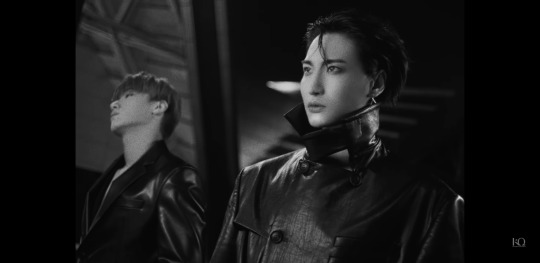
the texture is especially evident on San's face. I think they just put a noise filter over this part, which creates grain that you'd find on old film
So why not just film on film stock? It's expensive and cumbersome my guy. they filmed this between schedules like.... digital editing and stuff is just so much easier.
Which leads me to the next section:
K-Pop's Obsession with Wong Kar-Wai
STEP PRINTING!!!! 8/10FPS!!!!! STREAKS!!!! WE! LOVE! IT!
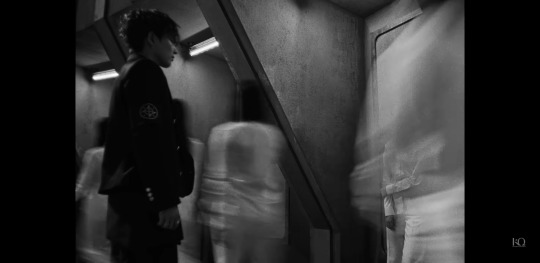

I fucking love this effect which WKW first did by filming (on stock) at 8 frames per second (fps) and then repeating the same frame 3 times to create that streakiness. Filming at a low frame rate then playing it at a higher one (usually 24 fps, which I'm guessing is also what they used for this trailer, 24-32(ish) fps is the cinematic standard) creates fast motion. This process is called step-printing.
The subject(s) would stay still/ move very slowly while filming to give the effect that everything is moving fast around them while they're normal speed. Super cool, gives sense that time is passing around them and/or isolation from others, which is what I think is intended here since HJ and the teezers are isolated from society as they're trying to fight against the government. sweet sweet storytelling through style. OBSESSED!
Here is an example from Chungking Express:
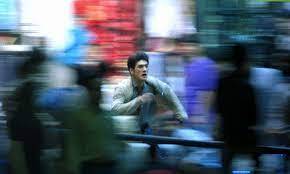
But also: K-Pop in general is OBSESSED with WKW's style. I will make a list of MVs that rep that eventually, but off the top my head, Mamamoo's mv for wind flower is inspired by Fallen Angels. The color grading, cinematography, the scene references etc.
Ateez and Metropolis
Now for something completely different: Before I get into it I really want to emphasize how fucking instrumental cinema was in globalization, because when cinema first became an industry it TRAVELED like TRAVELED. and resulted in a mix of styles since the fucking like 1920s. AMAZING
Okay so speaking of 1920s, let's get into IT! German Expressionism was a film movement that was born out of post-WW1 Germany and society's need to express (ha) the horrors of war they went through and since hyperinflation fucked up the economy so much, film companies were like "spend whatever" and blew budget on super elaborate film sets and facilities.
Expressionism is focused on the physical and really emphasizing features and such. It's hyperbolic as show in the screen shot from The Cabinet of Dr. Caligari:
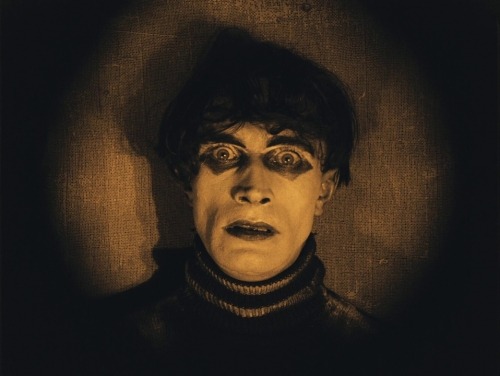
The subject's face is deepened by the make-up and lighting and shows their state of mind, a mindless corpse being controlled by another power (think Master/Puppet, but we don't have time to rly get into post WW1 Ger's anxieties)
It's also hyperbolic, as I said, which sometimes takes form in the sets. Specifically the establishing shots. These would traditionally be miniatures or painted, as they are easy and you can see how they're similar:
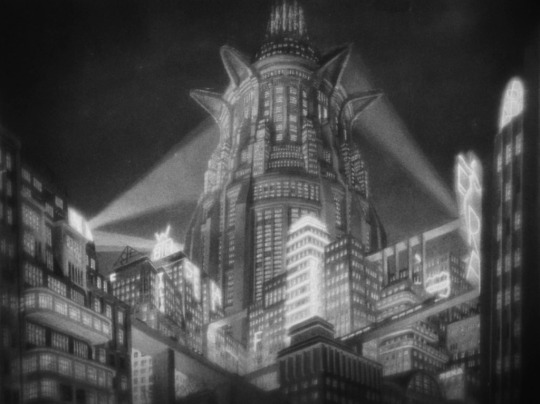
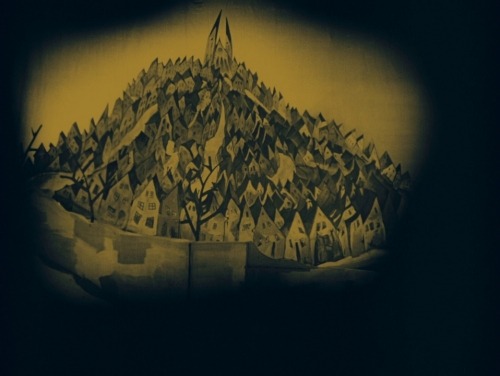
1- Metropolis & 2- The Cabinet of Dr. Caligari
Notice anything? The lines maybe? Perspective? Symmetry? These are all qualities seen in German Expressionism which I will get into in a momement but first. Let me explain why I use Metropolis as an example. In short, they already referenced it in Guerrilla:

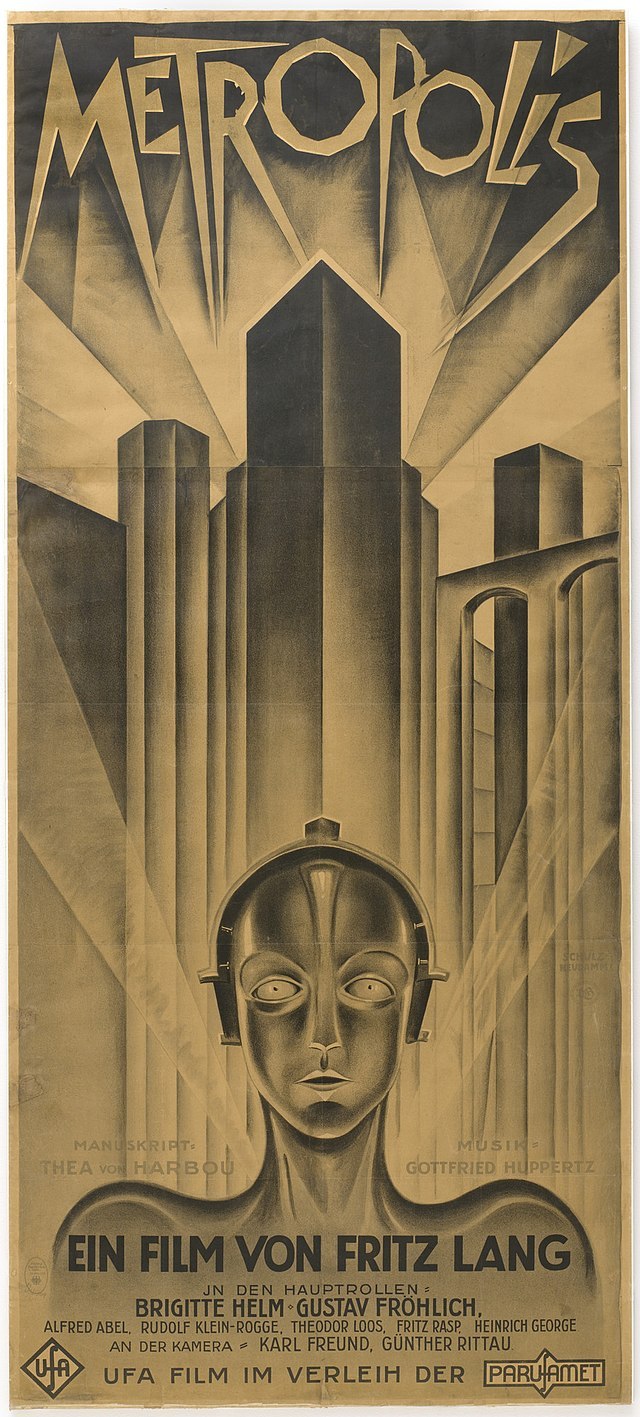
click to get the whole picture! Guerrilla MV and the film poster for Metropolis, the book cover is similar.
See the lines and perspective? The establishing shot at the beginning is the same, let's compare it to Metropolis again:


THE WORLD: EP.FIN Trailer & Metropolis
German expressionism is alive and well in film style and I'm so in love with how the director utilizes it.
Next, we're going to talk about structure and lines, along with style and how it helps the narrative.
[TO BE CONTINUED]
2 notes
·
View notes
Text
HIS STYLE OF PAINTING AND INFLUENCES

LET'S GO. so klaus' style of painting, let's see a few examples, first, alright? And a heads up, this is just my opinion as an art historian who just loves art. my favorite painting he has done on the show (other klaus blogs can reblog this if you want):


His landscapes can also be seen as romanticism, which makes sense, considering the movement is all about emotion and the subjectivity. thematically, it also makes sense due to the nature of vampirism itself and many of the themes that radiate through the show and klaus himself (nurture vs nature, the monster within, death, sex, romance).
Romanticism was characterized by its emphasis on emotion and individualism as well as glorification of all the past and nature, preferring the medieval rather than the classical.

I would say, however, he is very lean into Expressionism. makes sense, the main focus of expressionism is to subject the world to one’s personal view. what matter is what the artist is feeling and how he sees the world. klaus himself said once that painting was a metaphor for control he lacked as a kid. the canvas, the color the lines, it's all him, so it makes sense expressionism is the artwork he leans more into.
“Its typical trait is to present the world solely from a subjective perspective, distorting it radically for emotional effect in order to evoke moods or ideas. “
It’s also one of the art movements of the 20th century, and it started roughly around 1905 ending before the second world war, more or less. It makes sense considering canon, it’s a period of turbulance in his family as well; glory days in NOLA, the arrival of Mikael and going back into hiding, the 20′s and meeting Stefan, daggering Rebekah, meeting Elijah again. I can also see some influences from Cubism in the way the lines are sharp and visible and the objects seem to be reduced to their geometrical forms.
but I also spy with my little eye some Van Gogh, which is post-impressionism by his use of color and thick strokes. Obviously, he is 1000 years old and he surely goes through all art movements (though I hardly see him going for abstract or post-modernism or contemporary art of these days) but he does seem to rely heavily on the art of the 20th Century and the vanguard, which, makes sense. he wants to break away from the conventions, he himself is a break from the conventions of what nature dictated. vampire, werewolf, he was both and hence, a rule breaker, like vanguards were in the day. Klaus has many styles but I think we agree that he does have a constant imprint. I also see that in the paintings of the family, He goes for impressionism:

See how different the lines and colors are compared to the other paintings? the palette is softer , I mean the lighting in the picture is bad but you can see it, right? I can see some neoclassic elements in the way there is almost no movement but there is curves and body deformations to how he sees it fit and how he sees the world. He strikes me as a painter who takes his portrayed subject into account. Rebekah, fits perfectly into neoclassic and a softer palette.
Also, most of his art is figurative, meaning, you can recognize the elements that are being represented. Overall, I believe Klaus leans always toward Expressionism, Post-Impressionism, Romanticism and slight influences in some paintings of Cubism and neoclassic.
4 notes
·
View notes
Text
Degenerate Art and World War II
Art has throughout history held a different importance to the government and public. To some it has been an artisanal craft that needed to be protected, to some it has been a way to make money, and to some it has been a way to pass time. The popularity of certain styles have ebbed and flowed, with art of the western world slowly moving away from painting the objective, to painting the subjective. Within World War II the art world was especially turbulent. Leading up to it, styles like expressionism and impressionism had started taking form in the late 19th and early 20th century, and by the time the Nazi party began to rise to prominence, some of the most famous artists like Picasso and Chagall were painting scenes far from the religious iconography or photorealism of the previous centuries.
Degenerate art was at the time any art that the Nazi’s (particularly Adolf Hitler) disliked. This art could be essentially anything that was a part of the modern art movement (1860-1970): fauvism, bauhaus, cubism, surrealism, dada, expressionism, new objectivism, the list goes on. Artists faced both criticism and sanctions from the government, and were forced to face a changing public perception of their work. For those who partook in modern styles, they were (according to the government) presenting disgusting and horrible things as good. Their thinking was that because all art is good art under modern principles, that the objective good could be equated to the objective bad, and the objective bad could be equated to the objective good. They cited their fear for German culture being lost, and as a way to quell the issue, they put on art exhibits and publicly denounced art by seizing it and at times burning it. Because of those actions many paintings and sculptures have been lost and destroyed. The degenerate art exhibit of Munich (Entartete Kunst), taking place in 1937, held the art and criticisms of the most important artists of the time in Europe. Art that included within these exhibits could be generalised as having either ideological or racial differences to what the Nazi party wanted: it could be by Jewish/communist artists, be art that dishonoured women, be art against soldiers/the military, art that went against god, or be art that did not represent objectivity. So what was German art supposed to be? The art that was meant to be produced and was praised by the government was meant to be ‘distinctly’ German. It was to promote pro-Aryan and pro-Nazi values, and push nationalism to the populus. This art was often romanticism, realism, or classicism. This is something that can be seen quite apparently through the posters for the exhibits. The posters promoting the degenerate art exhibit are very modern and often experimental, including bright colours and extravagant detailing, while the posters promoting the great German art exhibit are very neoclassical and heroic in comparison. This idea of what was distinctly German however was not that realistic, considering the disapproval of die brücke and expression, a movement started in Dresden, Germany before World War I. New objectivism was also interestingly rejected by the Nazi’s, despite the fact that it existed because of a hatred against expressionism. As pointed out by Mary-Margaret Goggin in her article “Decent” vs. “Degenerate Art: The National Socialist Case, this thinking was not only racist and ideologically close-minded, but it’s based in misogyny. One of the classifications of art placed in the degenerate art exhibits was art that dishonoured women/was indecent, however the art that was positively exhibited was filled with women through the male gaze, and was overall filled with objectification. This was additionally hypocritical purely from the standpoint that the Nazi party hoped to eradicate religion after they won the war, and likely only complied with the Catholic Church because of the public. Ernst Ludwig Kirchner as an example had his paintings placed in these exhibits for his expressionist style. This style was one that was developed in the Die Brücke movement. The painters who were targetted by the Nazi’s would be visited to check whether or not they were painting by checking the wetness of their brushes. Emil Nolde was a significant expressionist who was targeted, but was also a Nazi party member.
Dada was a style of art and literature that held heavy influence on the styles that were considered degenerate. It itself came to fruition after World War I in Zurich, and was led majorly by artists who were against the bourgeois. These artists hoped to defy reason through irrationality. It reflected their opinions on world war 1, which was that it was an unnecessary and needless war. Because dada existed as a counterculture movement, it existed in opposition to the idea that good art required photorealism. Dada rebelled against the art precedent that was set and followed by groups like the pre-raphaelites, and existed as an amorphous rejection of the past. Dada art was created to outrage and provoke its audience, and was originally meant to transcend the boundaries of what was considered a movement.
Dadaism is often explained to be iconoclastic. Iconoclastic itself means that it is an attack on the beliefs of an institution, but historically refers to the destruction of the art of other civilisations. Iconoclasm was incredibly common during ancient times, and is the reason why so many of the remaining pieces of art found in graves and in temples have either been robbed or crushed. Dadaism follows the idea of destroying beliefs – many of the methods of dada art (like collage and photomontage) work by taking things from another source and cutting them up to be reused, but the idea of dada art is meant to reimagine what art is in a way separate from the ideas shaped by the past. After its inception, it developed in many places throughout the world, like Paris, New York, Berlin, and again Zurich – lasting from the late 1910’s to the mid 1920’s. Otto Dix and Hannah Höch are examples of dada artists who faced the wrath of the Nazi’s degenerate art exhibitions and burnings. War cripples by Otto Dix was a painting that directly criticised World War I and was burned, while Hannah Höch was unable to exhibit her art because of the censorship of the government that specifically targeted her. She was a pioneer of the photomontage style often associated with Dada. These photomontages create a cohesive image from scraps and random images, (where nothing is meant to seem out of place), but she also made collages (which attempt to make pieces that are more disconnected in their content). Both were labelled as degenerate artists by the Nazi government. Authors who were prevalent within this movement (and had heavy influence over surrealism) include Tristan Tzara. This literature of this movement was generally poetry, and for many was of the style of sound poetry. Raoul Hausmann was a prolific dadaist whose art was exhibited at the first degenerate art exhibit. It was similar to Hannah Höch in their usage of collage and photomontage, but he was also known for his poetry.
Dadaism held an extraordinary amount of influence on modern art as a whole. Surrealism was an art movement that was far more prevalent during the war (as opposed to dadaism, which had a few stragglers past the 20’s but didn’t really grow past that), but took very heavily from the ideas of dada that came in literature. Automatic writing was a thing that many dada writers did where the works were not contemplative, they were stream of consciousness. The idea of surrealism was coined by André Breton, who spoke about it based on its existence as a literary movement, however surrealist art had already begun to be made and was developing alongside its literary counterpart. It instead however took from automatic drawing and from illustrating dreams hyper realistically. This movement focused heavily on the subconscious, and took very major inspiration from psychologists and psychiatrists like Freud.
Thank you for reading!
0 notes
Text
Food Research
Related to studio inquiry and seminar paper
Cecilia Novero, Antidiets of the Avant-Garde book – reviewed by T. Nygard
“As a critical framework, Novero used concepts from the study of food, such as digestibility and indigestibility, to understand the cuisines developed by artists. The book also discusses the idea of symbolic incorporation of food, and non-food, into the body by eating it.”
Digestibility and indigestibility – I could do that – Michelin food and Abstract Expressionism
The link between the idea of simplicity being easy in art as well as food. “My child could have made that”, or “I too can put a leaf on a plate with a swirl of some sauce”
So, can we bring the idea of traditional food and its longevity to art? Traditional art forms like painting – can we approach them with the same view as traditional foods? Some people do, I suppose.
Preserving the art of painting through ideas of traditional food – not like old paintings. Traditional food is still alive and shifting; people try to find the purest or best version of traditional foods, why is it not ‘innovative’ enough to do the same with visual art?
We need art, we need to create, the same way we need to eat.
We eat to be together, we create art to be together. Self expression in both forms.
Tiziana Andina, “Can Food Be Art?” The Monist, Vol 101, no. 3 (July 2018) https://www.jstor.org/stable/26478113 - held up by theories of Kant
“If ‘food’ is understood as ‘cuisine’, we could say that it obviously involves the creative act of mixing its components together and subjecting them to different types of processing; also, food can be arranged on the plate in a way that is very similar to drawing a shape or making a sculpture. Nonetheless, there seems to be a fundamental difference between culinary products and paintings, sculptures, or music: in fact, however unpleasant a life without art may be, it is impossible to die because of a lack of aesthetic experience, whereas food is directly related to our physiology and is absolutely necessary for our survival.*
For this reason, even if food can be said to have aesthetic value, we have a very natural and physiological inclination towards it. But how can we feel a disinterested form of pleasure for something we know is indispensable for us? This point is stressed by the ‘Interest Exclusion Thesis’ defended by Kant, who maintains that aesthetic pleasure towards a given object should not be based on our desire for that object. He considers the pleasures of eating to be agreeable but not beautiful.”
So using that as art can hammer home social or theoretical concepts intended by the artist. We need food, we understand it innately; as it is directly related to our physiology; so making art from it creates a more visceral link between the viewer and the work.
Wing Sze Leung, The Moral Significance of Art in Kant’s Critique of Judgment: Imagination and the Performance of Imperfect Duties https://muse-jhu-edu.mtu.idm.oclc.org/article/700021
“Scholars interested in the moral significance of art in Kant’s account of aesthetic ideas in the Critique of Judgment (CJ) tend to focus on art’s ability to represent what Kant calls “moral ideas.” They further suggest that, in representing these ideas, art symbolizes our capacity to act according to moral laws. I argue that this reading fails to adequately capture the complexity of Kant’s account, for art’s capacity to represent moral ideas is intrinsically related to its ability to prompt a specific kind of mental operation among the audience—that is, a harmonious cooperation of imagination and understanding.”
“Joshua Landy, for instance, claims that narratives only “preach to the converted,” that is, narratives can improve us morally only if their values agree with ours” – not relevant, just interesting regarding the moral narratives within artworks.
“Poetry is Kant’s highest-valued art form in terms of its ability to express aesthetic ideas.”
0 notes
Text
POST MODERNITY
Modernism vs postmodernism
“Postmodernism can be seen as a reaction against the ideas and values of modernism.”
“The term is associated with scepticism, irony and philosophical critiques of the concepts of universal truths and objective reality.” (Postmodernism | Tate)
The term postmodernism was first used around the 1970s. It often embraces a variety of different approaches to art making but rejects the ideas of modernism. Modernism was usually based on the idea of idealism and had an utopian outlook on life. Modernist artists had a tendency to abstract their work. They rejected history and many conservative values, their work was often formulated by line, colour and shape in comparison to postmodernism that often focused on the subject and had a lot of complexity in their layers.
Modernism and postmodernism is a reaction to the enlightenment, a period in history during the 17th century where science, logic and reason started to outshine the ideas of faith, tradition and religion. Two of the main doctrines of the Enlightenment period were “the perfectibility of human nature” and “the belief in human progress through the development of human knowledge, especially the sciences” (University Quick Course, Modernism vs Postmodernism, 1:15). Many historians believe that this period was the start of the movement of modernism and postmodernism.
An example of modernism in the visual art world would be Vincent Van Gogh, who often “used an impulsive, gestural application of paint and symbolic colours to express subjective emotions. A method and practice that came to define many subsequent modern movements from fauvism to abstract expressionism.” (Vincent van Gogh Paintings, Bio, Ideas | TheArtStory). On the other hand an example of a postmodern artist would be Barbara Kruger. Famously known for her graphic compositions and influence on feminist art. She often explored questions of identity and gender that weren't at the time as commonly addressed. Kruger's bold graphic art style often critiqued consumerism and mass media. She, herself raised in a working class family, was aware of the implications postmodernism and modernism had on a lower class family. She often uses powerful images, mixed with typography to convey her messages successfully. It is her ‘signature look: high-contrast black and white photography with words set in bold block-shaped font’ that allowed her work to shine and grow her following who often agreed with her political statements. Two of her artworks that in particular reflect her ideologies of postmodernism include, ‘I shop therefore I am (1987)’ and ‘Your body is a battleground (1989). The first one being a way to fight against the ‘modern consumer-driven society’ fighting against the idea of mass production and over consumerism. (You Are Not Yourself: Barbara Kruger’s Influence on Feminist Art (thecollector.com))The second piece is a homage to the Woman’s March in Washington DC.
By Marta Kepinska
0 notes
Text
What Remains From Cinema’s Past in Modern-Day Films
By: Julia Kusmenko
As horror is a popular genre of the 21st Century, analyzing elements of some of the first horror movies can uncover the impact these films have on today’s horror. For example, the 1922 film Nosferatu and the 1946 film Bedlam are relevant to horror movies as they exist today.
As a product of German Expressionism, Nosferatu relates to modern-day films that feature the dark and dramatic elements indicative of this film style. In this film, the vampire Nosferatu follows a man named Hutter and his wife Ellen to their hometown where he infects the towns’ population. Two cinematic elements from Nosferatu that display the dark themes elements of the film are the shot of Nosferatu standing over a frightened Hutter in bed and the shot of the empty town with a procession of dead bodies being taken away. As stated by Phil McCarron, German Expressionism “dark, brooding window into the corrosive elements of the human body and soul” were explored thematically. Phil McCarron goes on to say that the dark elements of German Expressionism were shown “visually through the intense use of light & shadow and sharp angles, making the set a character in and of itself.”

A modern horror film that borrows the same dark style used in Nosferatu is the 2017 horror film Tigers Are Not Afraid. This film is set in a poor town in Mexico where kids are left to fend for themselves when their parents go missing due to the drug war. As this story tackles real-life themes, it depicts a darkness that is reminiscent of German Expressionism. Two cinematic elements from Tigers Are Not Afraid that display dark imagery are the shot of the character Estrella being haunted by the ghost of her mother and the shot of Estrella and her friends walking down an abandoned street with all their belongings. A historical event that relates to the elements of desolation shown in Nosferatu and Tigers Are Not Afraid is the Covid-19 pandemic as this was a dark time for humanity and caused many areas of the country to have significant numbers of deaths.

Furthermore, elements of the early horror film Bedlam influence today’s horror genre. Though it is a horror film, Bedlam serves as a social commentary about problematic practices within mental institutions in the United States. In relation to its social commentary about mental institutions, Bedlam is “‘a horror film in a more actual sense of the phrase,’ in so far as its subject matter makes it ‘morbid and depressing, but fascinating at the same time,’” (qtd. in Jancovich 34). In other words, though dark and disturbing, Bedlam sends a poignant message about society to the viewer. One characterization from Bedlam that connects to its message can be seen by the image of Master Sims treating a patient poorly. As written by Mark Vieira, Bedlam features a character named Master Sims who is “an inhuman bureaucrat who runs the St. Mary of Bethlehem asylum.” In addition, a moment from the film that shows the inhumane conditions of St. Mary’s of Bethlehem Asylum can be seen by the image of The Stonemason walking through a dark hallway of the asylum as the patients are kept in cells like prisoners.
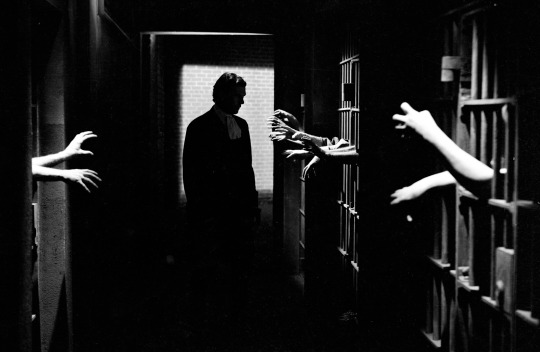
As modern movies send messages to the viewer about society, Bedlam connects to the social commentary that is commonly infused into modern-day horror films. For example, the 2017 horror film Get Out makes a statement about racial inequalities in the United States through its plot and character depictions. Two cinematic elements of Get Out that display its social commentary are the scene when Chris talks to Rose’s racist family members at a party and the shot when the police car arrives at the scene of the crime, implying messages about the state of racism in America. A historical event that connects to this theme is the Black Lives Matter movement of 2021 which centered around systematic issues still present in America. All in all, both Get Out and Bedlam touch on the idea that social institutions in America and aspects of American society are flawed. In this way, Bedlam serves as an inspiration for horror films to infuse social commentary into their plots. From this, early horror films such as Nosferatu and Bedlam incorporate elements that impact the horror films of today.
Works Cited
Jancovich, Mark. “Relocating Lewton: Cultural Distinctions, Critical Reception, and the Val Lewton Horror Films.” Journal of Film and Video, vol. 64, no. 3, 2012, pp. 21–37. JSTOR, https://doi.org/10.5406/jfilmvideo.64.3.0021. Accessed 15 Dec. 2023.
McCarron, Phil. “Fritz Lang - An Auteur of German Expressionism.” ESSAI, vol. 14, no. 26, 2016, pp. 100-102. https://dc.cod.edu/essai/vol14/iss1/26
Vieira, Mark. “Darkness, Darkness: The Films of Val Lewton.” Bright Lights Film Journal, 14 March 2021, https://brightlightsfilm.com/darkness-darkness-films-val-lewton-looking-back-b-movie-master/
0 notes
Text
08/24 - Drawing - Agnes Martin, Sheila Hicks, and Maggi Hambling Reflection Post
Agnes Martin:
Agnes Martin is a Canadian abstract painter known for her takes on the "abstract expressionism" and "minimalism" movements. She gains inspiration from having a "vacant mind" and automatically gaining an idea of what she would want to paint next from there. In other words, she claims that she does not have any ideas herself and would often sit still in silence until she gains the inspiration herself. Martin creates her pieces by first sketching the idea of a grid down on her notebook and then scales the sketch up to meet the dimensions of the canvas. She does this because the grid she proposes helps capture a sort of "innocence" or "state of being" that the inspiration she gets to make these minimalistic pieces revolves around. Martin applies the media of graphite pencils to first lay down the grid and then uses light yet long strokes of acrylic paint to apply pale colors to her pieces. When it comes to developing her own style of abstract expressionism, she didn't automatically gain her sense of minimalism from her pieces alone. Instead, she gained from a prolonged two decades of experimentation with painting and measurements (especially with the principle of repetition in her works). This inspires me to be more focused on letting go of my worries about experimenting due to chances of it going against the idea I want to portray because Martin's works have showed me that experimentation within art, especially abstract art, is what gives us the thrill of painting and coming back to it. Whenever I would feel like trying something new would not potentially work out, I would remember what Martin says towards inspiration, and it is that "beauty is not in the rose, it is in the mind."
Sheila Hicks:
Shiela Hicks is an American artist and sculptor who is known for her textile threaded sculptures and experimental works with kneaded materials. She gains the inspiration to create these installations from her impressions of her own early childhood, especially with how she would go on about her memories of playing hide-and-seek in corn fields would carry forth into her installations. In addition to this, Hicks gains inspiration from showing how color, texture, and form are tightly connected to each other. Hicks creates her pieces by weaving threads of natural textiles, where they overlap on one another and traverse a grid where the threads would soon move away from. Hicks experiments with all of these techniques because she wants to convince others that textile art does not need to rely solely on the grid; the art can "misbehave" and break itself open so that the whole installation can breathe. The media Hicks uses are natural textiles and threads, where Hicks shows more usage towards those that are more adaptable or flexible. Hicks's story of how her childhood memories and closeness with nature carries over to her art inspires me because it helps me learn that details in art do not necessarily have to be in line with a grid. In other words, I would think that a piece can also be broken apart into separate parts, each with individual small details that make the work all the more interesting!
Maggi Hambling:
Maggi Hambling is a British painter and sculptor who is known for her complex portraits and unique sculptures, especially from natural materials such as wood. Hambling gains inspiration from applying the mark of a subject onto a canvas or sculpture, whether it would be a person's head, a wave, or an object. She creates paintings focusing on portraits of subjects by making thick marks that align with the subject's head shape to give a feeling of certainty about the portrait's intimacy, in addition to claiming that with the way she paints these portraits, she claims that "every portrait is like a love affair." With her sculptures, she begins carving from pieces of bent wood that she had collected over the years and when the wood suggested an idea of a subject's head, she would carve and polish them in bronze coating. She goes about all of these techniques because she can envision applying little marks of details between paint to give a sense of overlap in her portraits and sculptures, in addition to having a sense of certainty guide her in debating whether a piece of hers could be considered "finished." The medium Maggi uses in her paintings is acrylic paint and the medium she uses in her sculptures is mainly wood. Hambling's story about how she would often be doubtful of herself towards her paintings and how fragile they can be in terms of how many marks they have reminds me of how I can be careful of how much "clutter" a piece can have, or how I can make a mark and would be inclined to make several more marks afterwards until they would look close to how I would envision the canvas's subject.
Out of all of the three videos, I would personally say that Agnes Martin's documentary would be my favorite because of how she explores the concept of beauty being in the mind instead of the subject in addition to how she tackles inspiration in mixing abstract expressionism and minimalism together to create something she would describe as "innocent."
1 note
·
View note
Text
headcanon dump ft. Hugh
After being confined to a painting for who knows how long, Hugh has lost a lot of touch with his physical body. He doesn't remember a lot of what things are supposed to feel like, taste like, sound like, or smell like. His vision is fine, but depth perception is a struggle for him at times.
He feels ghostly or not fully corporeal most of the time, so it's difficult for him to properly experience all the things his original body is capable of processing.
His expressions are also quite subdued and muted, although his emotions remain intact (for the most part). Due to the style of the painting he was bound to, many of his expressions were simplified, and thus he may struggle to make his expression fit his emotions and words.
As noted on his profile, his paintings are done using his own blood, hence why his left arm has a bunch of cuts and scars all over it from the shoulder down to his finger tips (though most congregate on his finger tips and wrist). To hide them, he wears long sleeves and gloves at all times of the year. His right wrist also has scars, but the rest of it is clean. His scars are very hard to hide with makeup so he opts to cover with clothing.
Hugh's paintings highlight styles used in modern art. His style ranges from an assortment of abstract and random shapes, lines, and block colors showcased in a highly abstract cubist style to making use of fauvist style's high contrast characteristic, using deep and varying shades of red, the color of the canvas, and black ink to highlight simplified eerie figures and scenery that might accompany a horror novel. Sometimes, he may produce a painting that follows abstract expressionism.
His sense of time is also very skewed when he returns to reality due to losing sense of time itself when he is within paintings (AKA he has no idea how long he has actually been on the other side).
Because he is bound to a painting and has been subject to its timeless rendition of his being, he no longer ages, and hence has lost the meaning of aging itself.
He can't stay too long outside in the real world and must return to to the painting every so often. The length of time he can stay outside varies every time he steps out so he can never give people a true estimate to how long he'll be gone for.
Paintings he can enter tend to tell him this via the voices of those on the other side of said painting, even if said painting doesn't depict animals or humans.
He could potentially bring people to the other side of paintings, but he has never tried to do this, as the other side is something he would never want people to experience at all (or at least the other side of the painting he is bound to).
0 notes
Text
Artist Statement: Internal Reflections (2023)
My installation, Internal Reflections, articulates the relationship between technology, anatomy, and the complex human mind.
I drew inspiration from the works of Susan Aldworth, Helen Pynor, Mika Tajima and Nicola López. Aldworth and Pynor explore contemporary anatomical research, the multiple paradoxes it presents (e.g. health and sickness), and people’s subjective experiences of the body to facilitate an empathetic response from the audience. Tajima and López, on the other hand, produce ‘landscapes’ that abstract human experiences into a tension between organic and geometric forms.
First, I made three linocuts from actual CT scans (one transverse scan and two coronal scans): brain, abdominal organs, and hand. I see anatomy as an integral part of the human experience, in the same way as identity or emotions.
I then printed monoprints onto Japanese Sumi (mulberry) paper. The colours and patterns for each monoprint had two purposes:
To serve as a reference to how CT scans are artificially coloured to highlight important areas – examples include:
Differentiating between different organs in a scan
Locating anything abnormal to determine a diagnosis
Examining bone density
To allude to the artistic history of colours being used to reflect one’s emotions and mental state (e.g. Expressionism).
As such the black lino-prints were then over-printed onto the monoprints, from these scans to create the basis of “an uncanny reflection”.
I paired this use of dual printmaking techniques with my approaches to scale and display. The display involved:
Lights shining behind the prints for luminosity.
A soundscape as an additional element
Suspension of the prints using fishing wire
Sumi paper is translucent, and the black ink absorbs the light shining behind each print. Emulating how artificially-coloured CT scans are displayed digitally, this creates a representation of contemporary research and technology through traditional techniques.
At the same time, the colours in the monoprint reveal the intricacy and ambiguity of our minds as well as our internal anatomy. This demonstrates how universal our desire to explore our psyche and body, regardless of the time period.
The looped soundscape is made from fragments of existing audio recordings of a CT scan. Had I been permitted, I would have pre-recorded the sounds myself.
Originally, I wanted to have smaller monochromatic photographs of the three different body parts, printed onto acetate and suspended alongside the prints.
Initially, it was intended to better accentuate the idea of the ‘uncanny reflection’. However, I felt that there was a disconnect between the photographs and the prints.
If I had more time, I would reshoot, edit and print some of these images. Here I have some photocopies as proof.
I also feel the images of the brain and torso are more successful than the hand. Given more time in the print studio, I would potentially work on inverting that print and look at changing the others.
I have a proof of concept here, which came about unintentionally and I am determined to explore this idea further.
Link to Art Studio Blog: https://www.tumblr.com/aangussca

Proof of Concept: Accompanying photographs (taken 10/11.5.23, edited 4.6.23)



Proof of Concept: Accidental inverted print (made 2.6.23)

0 notes